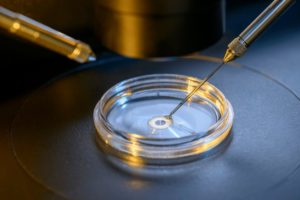A key decision you may have to make before undergoing IVF is when to transfer your embryo or embryos. This choice is often divided into two major options: “fresh” or “frozen” embryo transfers. Other than the clear similarity in terminology to how one gets their vegetables, you may not know much about these two choices. Some clinics have begun recommending only frozen transfers for a variety of reasons, but others may consider a fresh transfer. No matter what the reason, the main difference between a fresh and a frozen transfer is time. The second difference is the medications, namely the type and timing of the medications used.
The technical steps for placing the embryo(s) into your uterus is the same for both fresh and frozen transfers and is similar to a PAP smear exam. The timing of when the embryo is placed into your uterus (or womb) is intended to be the same as when an embryo enters into your uterus naturally, namely within the week following ovulation. With a “fresh” transfer, the transfer occurs in the days after your retrieval, if you imagine your retrieval is like ovulation. In a “frozen” transfer however, the transfer is in a different cycle than your retrieval. The embryos will need to be cryopreserved or “frozen” in time so they can be put in at just the right time of the cycle.

Why do a fresh transfer?
The main reasons for a fresh transfer are cost control and embryo selection. Fresh embryo transfers are performed in the same cycle as the retrieval. This means the uterine environment is already prepared for the embryo to implant and minimal additional steps are needed before placing the embryos into your uterus. This includes less work by the embryology team, fewer medications for a shorter time, and less ultrasounds and labs, all of which mean less cost. If you are traveling for your fertility care, having the embryo(s) transferred in the retrieval cycle also means not having to pay the additional cost of traveling back another time for a frozen transfer.
In a fresh transfer however the ability to select the best embryos is limited to the appearance or “morphology”. This means the embryologist looks at all the features of the embryo and choses the one or ones that look like they have the best chance of implanting and becoming a successful pregnancy. This selection process is good but isn’t perfect. If there are other factors that would suggest a lower chance of success, such as having older eggs or previous unsuccessful transfers, your doctor may suggest transferring more than one embryo to increase the odds of pregnancy in that cycle. Transferring more than one embryo does increase your odds of success, however sometimes it works a little too well and you get more than one baby at a time (i.e. twins and triplets).
In some women, the ability to select a great embryo is more simple. For a young woman who and has lots of equally good embryos, all embryos have a good chance of becoming a pregnancy. This could holds true for women using eggs from an egg donor. Embryos resulting from donated eggs tend to all have high chance of pregnancy and so any single embryo can be chosen for transfer. On the other hand, if you only have one or two embryos to chose from there is no need to decide which is best as all could be transferred. So if cost is a concern or the selection of the embryos to transfer is straightforward, having a fresh embryo transfer may be an option to consider.
Why do a frozen transfer?
In the early days of IVF, embryo freezing was not very reliable and embryos often did not survive the freeze/thaw process. As such, much of the data on success rates in the literature is based on fresh transfer pregnancy rates. As science has gotten better at growing and developing embryos, the number of available embryos for transfer has increased and additional tools are needed the to select best quality embryos. Additionally, pregnancy rates in fresh transfer cycles have stayed the same while the success rates after frozen transfers have increased, often exceeding the fresh cycle rates with the advent of newer laboratory techniques. Occasionally situations may arise in a fresh cycle that would necessitate delaying the transfer, such as the example of ovarian hyper stimulation syndrome (OHSS).
One tool to assist in selecting embryos is pre-implantation genetic testing (PGT, formerly called PGS). This is a method to identify the genetic competency of the embryos by sampling a few cells and performing genetic analysis. The method is very accurate and safe, however may take several weeks for the results to be reported. As such an embryo transfer needs to be postponed pending the results. Embryos can be tested for genetic competency on day 5, 6 or 7 of development but embryos are ideally placed into your uterus on “day 5” at the latest. By freezing a day 6 or 7 embryo, it can be thawed and placed into your uterus on “day 5” in the next cycle and have a better chance of pregnancy than if it was placed on the later day.
Success rates of an embryo transfer depend on lots of factors. The lining of your uterus grows in response to estrogen. The ability to accept your embryo (implantation) depends for the most part on timing and amount of progesterone. In a fresh transfer following retrieval your estrogen level is higher than in a natural menstrual cycle. This can cause uterine lining changes, which may reduce your odds of implantation. In an extreme example, OHSS results after a large number of eggs are retrieved and your estrogen level is very high. A fresh transfer in this scenario has lower chances of success but also can make the symptoms of OHSS worse so your doctor may recommend delaying your transfer if you have OHSS. Some women may have a rapid increase in progesterone levels during the stimulation cycle and this may lead your doctor to recommend delaying your transfer to another cycle as well. Finally, some women are not planning to be pregnant right away for a variety of reasons and may choose to “bank embryos”. This means retrieving your eggs, fertilizing them and creating embryos, but delaying the embryo transfer until next year or even several years later. In this scenario, when you are ready to be pregnant you would undergo a frozen embryo transfer.
The choice to have a fresh or a frozen transfer depends on so many personal factors. This is an important decision and should be discussed early on in the time leading up to starting your IVF cycle.
The Destination Fertility Team
